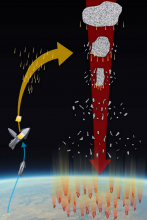Listen to today's episode of StarDate on the web the same day it airs in high-quality streaming audio without any extra ads or announcements. Choose a $8 one-month pass, or listen every day for a year for just $30.
You are here
Megatsunami
3.4 billion years ago, an asteroid the size of a town slammed into an ocean on Mars. It ripped up the sea floor, blasted rock and water vapor high into the sky, and changed the climate across the entire planet. It also generated a tsunami that raced a thousand miles in every direction, dropping boulders far from the impact site. And the first successful Mars lander, Viking 1, set down amid those boulders in 1976.
That’s the scenario outlined in a recent study. Researchers based their findings on the discovery of a large impact crater hundreds of miles from the landing site, and on computer simulations.
Before Viking touched down, scientists had expected to find smooth volcanic plains at the landing site, in a region known as Chryse Planitia. In fact, the site was chosen in part because engineers wanted a smooth, safe spot for the lander. Instead, Viking’s pictures showed lots of boulders.
The origin of those boulders has been a mystery. The new study provides a possible explanation.
The crater is about 60 miles across. It could have been gouged by an asteroid a few miles in diameter. The blast would have been at least 10,000 times more powerful than the largest H-bomb ever tested — creating a megatsunami on the surface of Mars.
Mars stands high overhead at nightfall, and looks like a bright orange star. It’s not far from a fainter orange light, the star Aldebaran. They set by 2 or 3 a.m.
Script by Damond Benningfield





